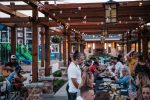Great Communities Start with Amazing Residents’ Associations
A healthy community is one that engages all its residents, giving them reasons to explore and connect beyond their own four walls. Our Residents’ Associations make this happen.
A lot of careful planning and research goes into building one of our award-winning communities. Before the shovel hits the ground in a new community, Brookfield Residential along with our team of planners, engineers, and architects work tirelessly to consider all the factors that contribute to an amazing quality of life for residents. Using healthy planning principles improve public health, promotes healthier lifestyles, and fosters a community culture with a strong sense of place and belonging. Personal wellbeing is one of the highest ranked indicators when it comes to overall satisfaction, according to Brookfield Residential livability research. Each Brookfield Residential community supports physical activity, social connections, and inspires residents to build healthy lifestyles so they can love where they live.

Brookfield focuses on the following seven principles to promote health and wellness within the planning and design stage for each community:
#1 Active Living: Research shows that people are more likely to change based on feelings and emotions rather than logic alone. We ensure there are a variety of open spaces in our communities, making it easy for residents to be active and practice daily movement. Additionally, by connecting services and amenities within walking distance to each neighbourhood through an integrated pathway system, residents are able to walk their kids to school, hop on their bike to pick up last minute ingredients, and more, all while leaving their car at home.
#2 Residents’ Associations: A Residents’ Association (RA) can be a platform to inspire residents and connect local partners in health through both an online concierge service and/or a designated RA building to bring people together. An engaged and connected community, coupled with an opportunity to socialize with and meet your neighbours, heightens the quality of life for residents to be happier, healthier homeowners.
#3 Energize Shared Spaces: (A Four Seasons approach) Did you know that loneliness rivals obesity and smoking in terms of health risk? Building and facilitating meaningful connections in a community combats loneliness and reduces heart disease. Public gathering spaces can have a direct positive impact on human health. Simple programming and a central gathering space, such as a RA, can get people together and encourage residents to participate in their community.

#4 Access to Healthy Food: The foods you eat affect the quality of your cells, tissues, organs, and mind. Having access to healthy dietary options is a critical component in supporting a healthy community. Healthy Food Partnerships provide access to food early in the development stage by identifying a centralized space for temporary farmer’s markets or food trucks. Planning for urban agriculture or community gardens is a key feature of planning our communities. As stated in the article titled Health Benefits of Urban Agriculture, “The experience of growing food is correlated with its consumption: the more experience people have growing food, the more likely they are to introduce healthy foods into their diets”.
#5 All Ages and Abilities: It is critical to us when planning and developing communities that everyone feels welcomed, safe, and engaged 24/7, regardless of background or physical ability. From parks and open spaces, illuminated pathways, to a large variety of housing options, all aspects of community design are considered for every age, life stage and physical ability, to grow within the community.
#6 Unique Character and Public Art: Each one of our communities has a strict set of guidelines for architecture and landscaping. These guidelines contribute to a community's identity, foster community pride, incite a sense of belonging, protect resale value of residents’ home investment, and enhance the quality of life for residents and visitors. Public art and unique landscaping features help people feel connected and welcomed with a sense of pride for their community.
#7 Preserve Significant Environmental Features: Nature has an excellent ability to heal and calm us. Connecting to nature significantly reduces stress and supports one’s emotional and spiritual well-being. Managing stormwater and preserving significant environmental features allows residents to downshift and recharge with nature within their community.